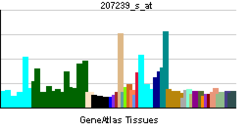- PCTK1
-
Cyclin-dependent kinase 16 Identifiers Symbols CDK16; FLJ16665; PCTAIRE; PCTAIRE1; PCTGAIRE; PCTK1 External IDs OMIM: 311550 MGI: 97516 HomoloGene: 7878 GeneCards: CDK16 Gene EC number 2.7.11.22 Gene Ontology Molecular function • nucleotide binding
• protein kinase activity
• protein serine/threonine kinase activity
• cyclin-dependent protein kinase activity
• protein binding
• ATP bindingBiological process • protein phosphorylation Sources: Amigo / QuickGO RNA expression pattern 


More reference expression data Orthologs Species Human Mouse Entrez 5127 18555 Ensembl ENSG00000102225 ENSMUSG00000031065 UniProt Q00536 Q3TM24 RefSeq (mRNA) NM_001170460.1 NM_011049.4 RefSeq (protein) NP_001163931.1 NP_035179.1 Location (UCSC) Chr X:
47.08 – 47.09 MbChr X:
20.27 – 20.28 MbPubMed search [1] [2] Serine/threonine-protein kinase PCTAIRE-1 is an enzyme that in humans is encoded by the PCTK1 gene.[1][2]
The protein encoded by this gene belongs to the cdc2/cdkx subfamily of the ser/thr family of protein kinases. It may play a role in signal transduction cascades in terminally differentiated cells. This gene is thought to escape X inactivation. Two transcript variants encoding the same protein have been found for this gene.[2]
Interactions
PCTK1 has been shown to interact with CDK5R1.[3]
References
- ^ Okuda T, Cleveland JL, Downing JR (Dec 1992). "PCTAIRE-1 and PCTAIRE-3, two members of a novel cdc2/CDC28-related protein kinase gene family". Oncogene 7 (11): 2249–58. PMID 1437147.
- ^ a b "Entrez Gene: PCTK1 PCTAIRE protein kinase 1". http://www.ncbi.nlm.nih.gov/sites/entrez?Db=gene&Cmd=ShowDetailView&TermToSearch=5127.
- ^ Cheng, Kai; Li Zhen, Fu Wing-Yu, Wang Jerry H, Fu Amy K Y, Ip Nancy Y (Aug. 2002). "Pctaire1 interacts with p35 and is a novel substrate for Cdk5/p35". J. Biol. Chem. (United States) 277 (35): 31988–93. doi:10.1074/jbc.M201161200. ISSN 0021-9258. PMID 12084709.
Further reading
- Meyerson M, Enders GH, Wu CL, et al. (1992). "A family of human cdc2-related protein kinases.". EMBO J. 11 (8): 2909–17. PMC 556772. PMID 1639063. http://www.pubmedcentral.nih.gov/articlerender.fcgi?tool=pmcentrez&artid=556772.
- Knight JC, Renwick PJ, Downing JR, Okuda T (1995). "Physical linkage of the cdc2-related gene (PCTK1) and the ubiquitin-activating enzyme E1 gene (UBE1) on human Xp11.3.". Cytogenet. Cell Genet. 71 (2): 155–7. doi:10.1159/000134097. PMID 7656587.
- Okuda T, Valentine VA, Shapiro DN, Downing JR (1994). "Cloning of genomic loci and chromosomal localization of the human PCTAIRE-1 and -3 protein kinase genes.". Genomics 21 (1): 217–21. doi:10.1006/geno.1994.1245. PMID 8088790.
- Carrel L, Clemson CM, Dunn JM, et al. (1997). "X inactivation analysis and DNA methylation studies of the ubiquitin activating enzyme E1 and PCTAIRE-1 genes in human and mouse.". Hum. Mol. Genet. 5 (3): 391–401. doi:10.1093/hmg/5.3.391. PMID 8852665.
- Sladeczek F, Camonis JH, Burnol AF, Le Bouffant F (1997). "The Cdk-like protein PCTAIRE-1 from mouse brain associates with p11 and 14-3-3 proteins.". Mol. Gen. Genet. 254 (5): 571–7. doi:10.1007/s004380050453. PMID 9197417.
- Esposito T, Gianfrancesco F, Ciccodicola A, et al. (1997). "Escape from X inactivation of two new genes associated with DXS6974E and DXS7020E.". Genomics 43 (2): 183–90. doi:10.1006/geno.1997.4797. PMID 9244435.
- Yu X, Wu LC, Bowcock AM, et al. (1998). "The C-terminal (BRCT) domains of BRCA1 interact in vivo with CtIP, a protein implicated in the CtBP pathway of transcriptional repression.". J. Biol. Chem. 273 (39): 25388–92. doi:10.1074/jbc.273.39.25388. PMID 9738006.
- Le Bouffant F, Capdevielle J, Guillemot JC, Sladeczek F (1998). "Characterization of brain PCTAIRE-1 kinase immunoreactivity and its interactions with p11 and 14-3-3 proteins.". Eur. J. Biochem. 257 (1): 112–20. doi:10.1046/j.1432-1327.1998.2570112.x. PMID 9799109.
- Besset V, Rhee K, Wolgemuth DJ (1999). "The cellular distribution and kinase activity of the Cdk family member Pctaire1 in the adult mouse brain and testis suggest functions in differentiation.". Cell Growth Differ. 10 (3): 173–81. PMID 10099831.
- Cheng K, Li Z, Fu WY, et al. (2002). "Pctaire1 interacts with p35 and is a novel substrate for Cdk5/p35.". J. Biol. Chem. 277 (35): 31988–93. doi:10.1074/jbc.M201161200. PMID 12084709.
- Graeser R, Gannon J, Poon RY, et al. (2003). "Regulation of the CDK-related protein kinase PCTAIRE-1 and its possible role in neurite outgrowth in Neuro-2A cells.". J. Cell. Sci. 115 (Pt 17): 3479–90. PMID 12154078.
- Strausberg RL, Feingold EA, Grouse LH, et al. (2003). "Generation and initial analysis of more than 15,000 full-length human and mouse cDNA sequences.". Proc. Natl. Acad. Sci. U.S.A. 99 (26): 16899–903. doi:10.1073/pnas.242603899. PMC 139241. PMID 12477932. http://www.pubmedcentral.nih.gov/articlerender.fcgi?tool=pmcentrez&artid=139241.
- Wu K, Bottazzi ME, de la Fuente C, et al. (2004). "Protein profile of tax-associated complexes.". J. Biol. Chem. 279 (1): 495–508. doi:10.1074/jbc.M310069200. PMID 14530271.
- Ota T, Suzuki Y, Nishikawa T, et al. (2004). "Complete sequencing and characterization of 21,243 full-length human cDNAs.". Nat. Genet. 36 (1): 40–5. doi:10.1038/ng1285. PMID 14702039.
- Gerhard DS, Wagner L, Feingold EA, et al. (2004). "The status, quality, and expansion of the NIH full-length cDNA project: the Mammalian Gene Collection (MGC).". Genome Res. 14 (10B): 2121–7. doi:10.1101/gr.2596504. PMC 528928. PMID 15489334. http://www.pubmedcentral.nih.gov/articlerender.fcgi?tool=pmcentrez&artid=528928.
- Ross MT, Grafham DV, Coffey AJ, et al. (2005). "The DNA sequence of the human X chromosome.". Nature 434 (7031): 325–37. doi:10.1038/nature03440. PMC 2665286. PMID 15772651. http://www.pubmedcentral.nih.gov/articlerender.fcgi?tool=pmcentrez&artid=2665286.
- Palmer KJ, Konkel JE, Stephens DJ (2005). "PCTAIRE protein kinases interact directly with the COPII complex and modulate secretory cargo transport.". J. Cell. Sci. 118 (Pt 17): 3839–47. doi:10.1242/jcs.02496. PMID 16091426.
- Rual JF, Venkatesan K, Hao T, et al. (2005). "Towards a proteome-scale map of the human protein-protein interaction network.". Nature 437 (7062): 1173–8. doi:10.1038/nature04209. PMID 16189514.
- Liu Y, Cheng K, Gong K, et al. (2006). "Pctaire1 phosphorylates N-ethylmaleimide-sensitive fusion protein: implications in the regulation of its hexamerization and exocytosis.". J. Biol. Chem. 281 (15): 9852–8. doi:10.1074/jbc.M513496200. PMID 16461345.
Categories:- Human proteins
- Chromosome X gene stubs
Wikimedia Foundation. 2010.
